Abstract
Generation of superoxide anion (O2-) in response to occupancy of neutrophil chemoattractant receptors requires both early events ('triggering') and sustained signals ('activation'). We have previously demonstrated that occupancy of adenosine A2 receptors inhibits O2- generation by neutrophils. In parallel, adenosine-receptor occupancy promotes association of bound N-formylmethionyl-leucyl-phenylalanine (fMLP) receptors with the cytoskeleton, a process associated with termination of neutrophil activation (stimulus-response uncoupling). We undertook this study to determine whether inhibition of neutrophil function by adenosine-receptor occupancy requires intact actin filaments and to examine the effect of adenosine-receptor occupancy on the stimulated generation of intracellular signals involved in neutrophil triggering and activation. Occupancy of adenosine A2 receptors by 5'-N-ethylcarboxamidoadenosine (NECA, 1 microM) significantly increased (130 +/- 1% of control, P less than 0.001, n = 3) association of [3H]fMLP with cytoskeletal preparations. Cytochalasin B (5 micrograms/ml), an agent which disrupts actin filaments, completely blocked association of [3H]fMLP with cytoskeletal preparations, as previously reported. However, NECA markedly increased association of [3H]fMLP with the cytoskeleton even in the presence of cytochalasin B (P less than 0.0002). Moreover, NECA did not significantly affect either the early (30s) or the late (5 min) formation of actin filaments after stimulation by chemoattractant (fMLP, 0.1-100 nM). Cytochalasin B markedly inhibited actin-filament formation by stimulated neutrophils, and NECA did not reverse the effect of cytochalasin B on actin-filament formation. Adenosine-receptor occupancy did not affect the rapid peak in diacylglycerol generation (less than or equal to 15 s) from either [3H]arachidonate- or [14C]glycerol-labelled phospholipid pools. However, as would be predicted if occupancy of the adenosine receptor was a signal for early termination of cell activation, NECA (1 microM) markedly diminished the slow sustained generation of diacylglycerol. These results suggest that adenosine-A2-receptor occupancy does not affect triggering of the neutrophil, but that occupancy of adenosine receptors is an early signal for the termination of neutrophil activation, i.e. the 'premature' finish of signal transduction. Moreover, these data indicate that at least two pathways are available for increasing the association of ligated chemoattractant receptors with the cytoskeleton of neutrophils: F-actin-dependent and -independent.
Full text
PDF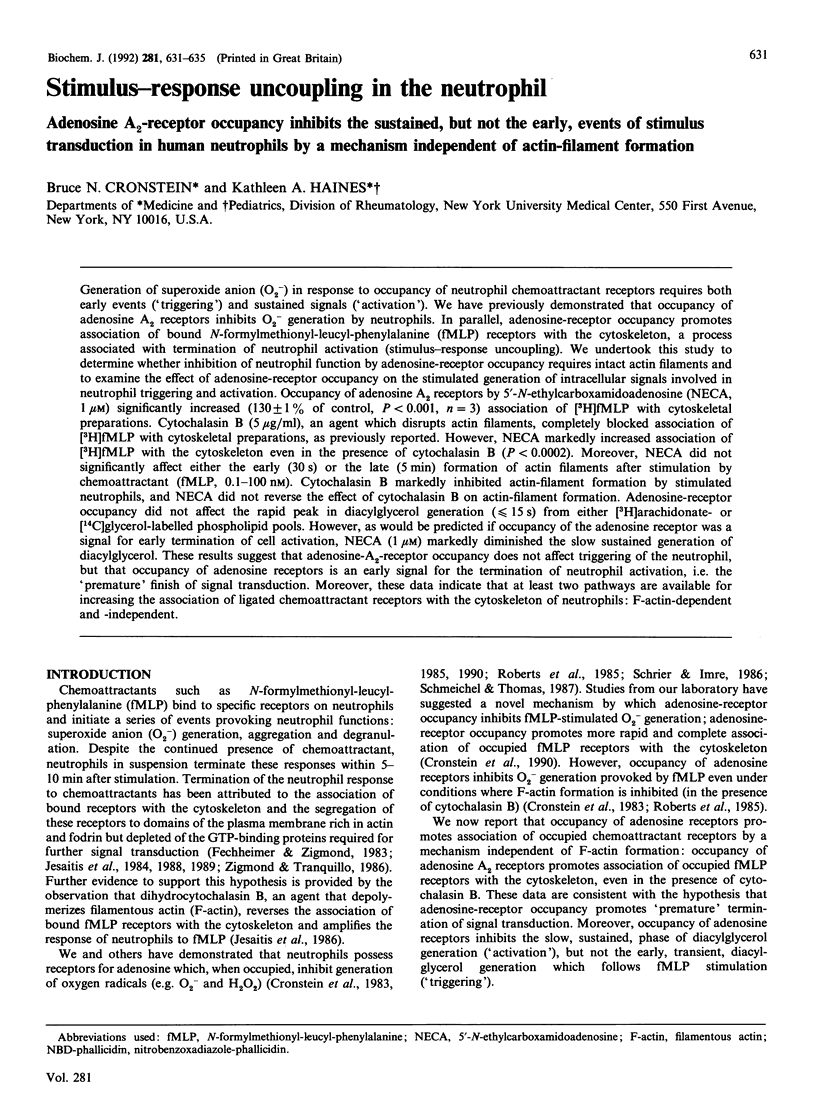
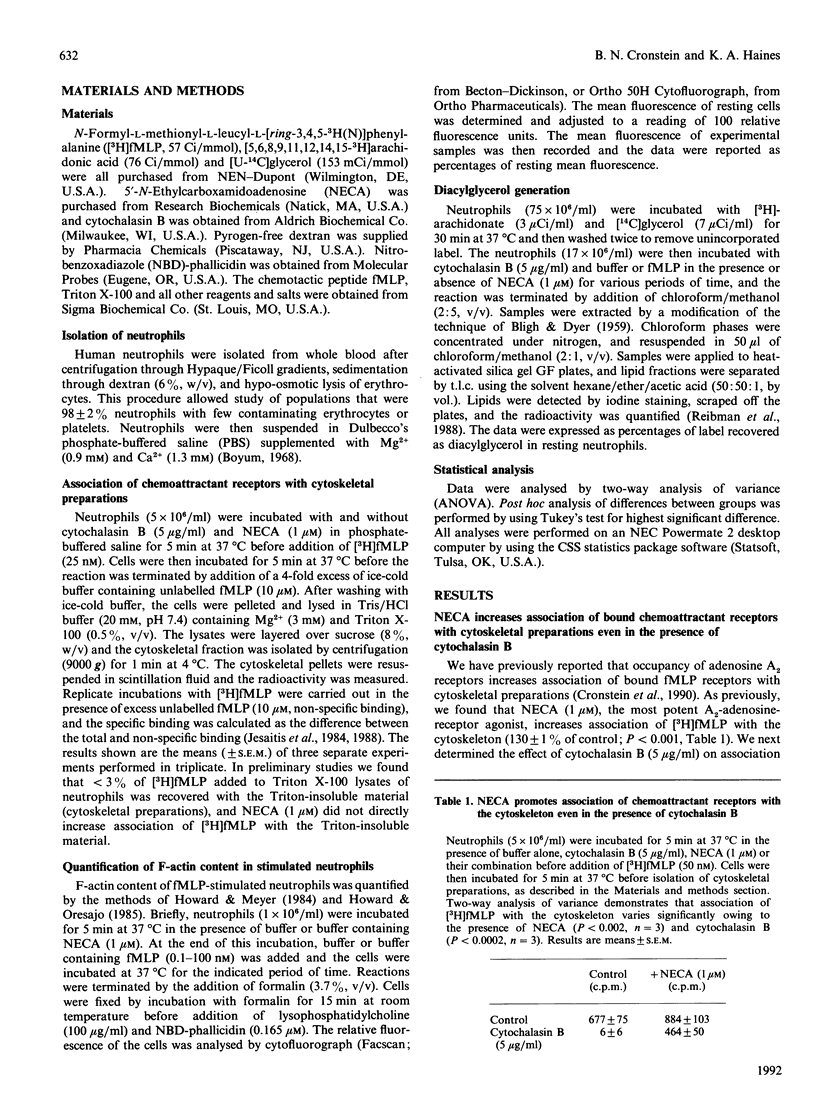
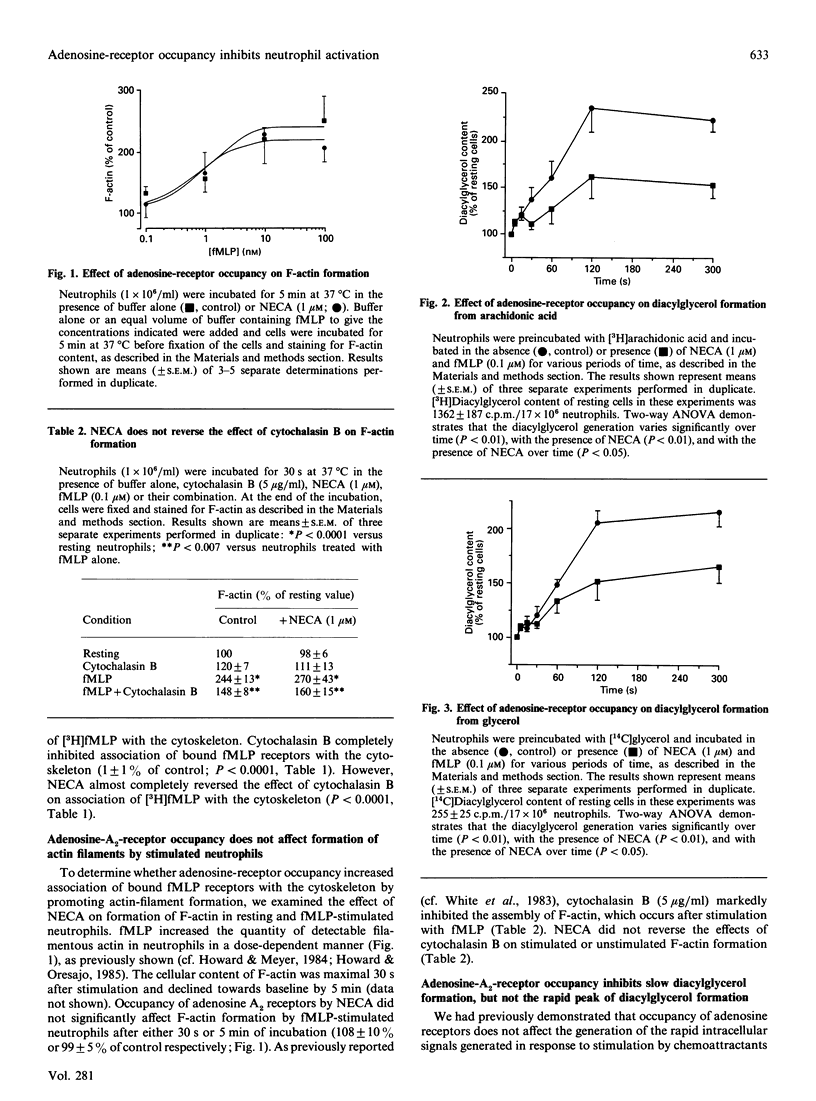
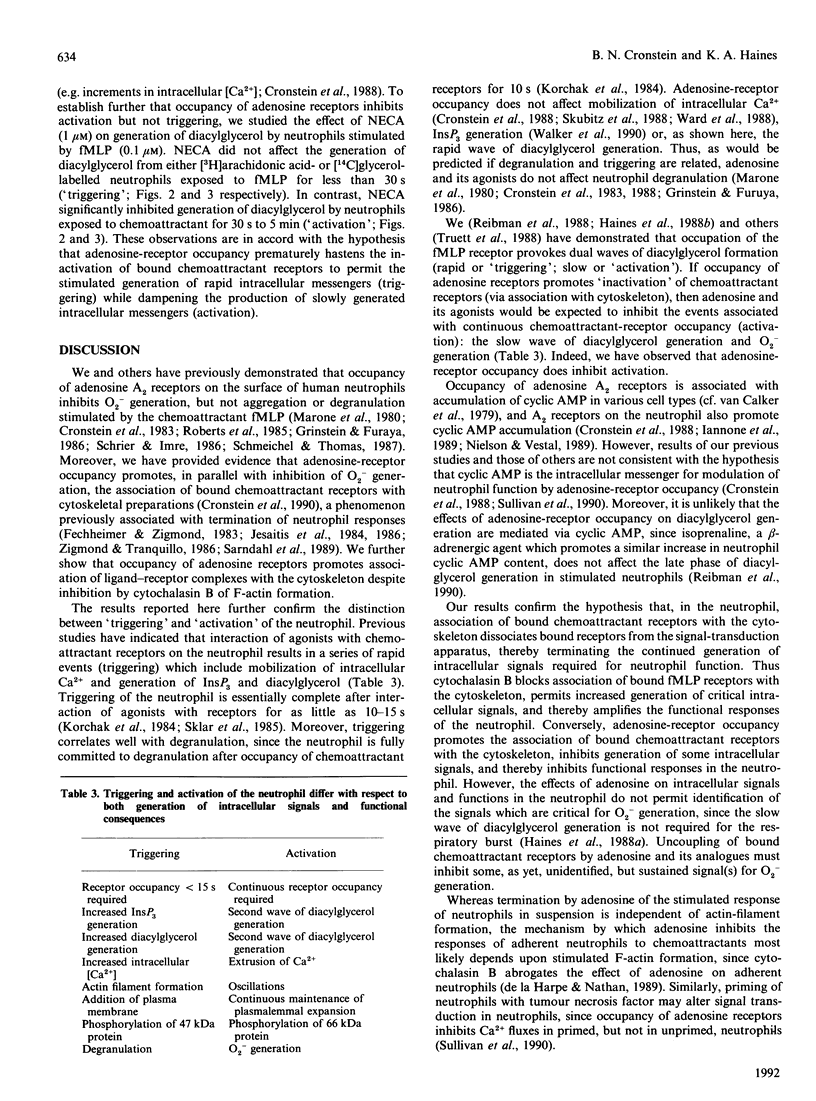
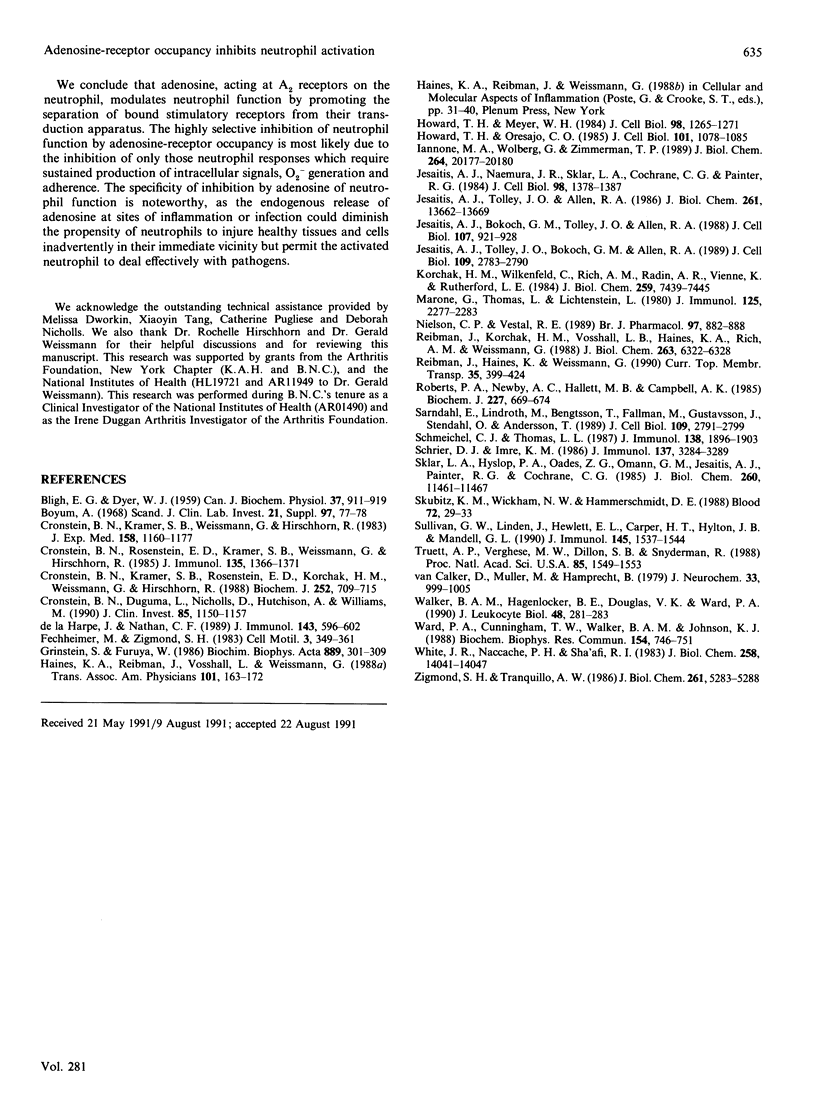
Selected References
These references are in PubMed. This may not be the complete list of references from this article.
- BLIGH E. G., DYER W. J. A rapid method of total lipid extraction and purification. Can J Biochem Physiol. 1959 Aug;37(8):911–917. doi: 10.1139/o59-099. [DOI] [PubMed] [Google Scholar]
- Cronstein B. N., Daguma L., Nichols D., Hutchison A. J., Williams M. The adenosine/neutrophil paradox resolved: human neutrophils possess both A1 and A2 receptors that promote chemotaxis and inhibit O2 generation, respectively. J Clin Invest. 1990 Apr;85(4):1150–1157. doi: 10.1172/JCI114547. [DOI] [PMC free article] [PubMed] [Google Scholar]
- Cronstein B. N., Kramer S. B., Rosenstein E. D., Korchak H. M., Weissmann G., Hirschhorn R. Occupancy of adenosine receptors raises cyclic AMP alone and in synergy with occupancy of chemoattractant receptors and inhibits membrane depolarization. Biochem J. 1988 Jun 15;252(3):709–715. doi: 10.1042/bj2520709. [DOI] [PMC free article] [PubMed] [Google Scholar]
- Cronstein B. N., Kramer S. B., Weissmann G., Hirschhorn R. Adenosine: a physiological modulator of superoxide anion generation by human neutrophils. J Exp Med. 1983 Oct 1;158(4):1160–1177. doi: 10.1084/jem.158.4.1160. [DOI] [PMC free article] [PubMed] [Google Scholar]
- Cronstein B. N., Rosenstein E. D., Kramer S. B., Weissmann G., Hirschhorn R. Adenosine; a physiologic modulator of superoxide anion generation by human neutrophils. Adenosine acts via an A2 receptor on human neutrophils. J Immunol. 1985 Aug;135(2):1366–1371. [PubMed] [Google Scholar]
- Fechheimer M., Zigmond S. H. Changes in cytoskeletal proteins of polymorphonuclear leukocytes induced by chemotactic peptides. Cell Motil. 1983;3(4):349–361. doi: 10.1002/cm.970030406. [DOI] [PubMed] [Google Scholar]
- Grinstein S., Furuya W. Cytoplasmic pH regulation in activated human neutrophils: effects of adenosine and pertussis toxin on Na+/H+ exchange and metabolic acidification. Biochim Biophys Acta. 1986 Dec 19;889(3):301–309. doi: 10.1016/0167-4889(86)90192-8. [DOI] [PubMed] [Google Scholar]
- Haines K. A., Reibman J., Vosshall L., Weissmann G. Neutrophil activation: evidence for two sources of diacylglycerol distinguished by protein I of Neisseria gonorrhoeae. Trans Assoc Am Physicians. 1988;101:163–172. [PubMed] [Google Scholar]
- Howard T. H., Meyer W. H. Chemotactic peptide modulation of actin assembly and locomotion in neutrophils. J Cell Biol. 1984 Apr;98(4):1265–1271. doi: 10.1083/jcb.98.4.1265. [DOI] [PMC free article] [PubMed] [Google Scholar]
- Howard T. H., Oresajo C. O. The kinetics of chemotactic peptide-induced change in F-actin content, F-actin distribution, and the shape of neutrophils. J Cell Biol. 1985 Sep;101(3):1078–1085. doi: 10.1083/jcb.101.3.1078. [DOI] [PMC free article] [PubMed] [Google Scholar]
- Iannone M. A., Wolberg G., Zimmerman T. P. Chemotactic peptide induces cAMP elevation in human neutrophils by amplification of the adenylate cyclase response to endogenously produced adenosine. J Biol Chem. 1989 Dec 5;264(34):20177–20180. [PubMed] [Google Scholar]
- Jesaitis A. J., Bokoch G. M., Tolley J. O., Allen R. A. Lateral segregation of neutrophil chemotactic receptors into actin- and fodrin-rich plasma membrane microdomains depleted in guanyl nucleotide regulatory proteins. J Cell Biol. 1988 Sep;107(3):921–928. doi: 10.1083/jcb.107.3.921. [DOI] [PMC free article] [PubMed] [Google Scholar]
- Jesaitis A. J., Naemura J. R., Sklar L. A., Cochrane C. G., Painter R. G. Rapid modulation of N-formyl chemotactic peptide receptors on the surface of human granulocytes: formation of high-affinity ligand-receptor complexes in transient association with cytoskeleton. J Cell Biol. 1984 Apr;98(4):1378–1387. doi: 10.1083/jcb.98.4.1378. [DOI] [PMC free article] [PubMed] [Google Scholar]
- Jesaitis A. J., Tolley J. O., Allen R. A. Receptor-cytoskeleton interactions and membrane traffic may regulate chemoattractant-induced superoxide production in human granulocytes. J Biol Chem. 1986 Oct 15;261(29):13662–13669. [PubMed] [Google Scholar]
- Jesaitis A. J., Tolley J. O., Bokoch G. M., Allen R. A. Regulation of chemoattractant receptor interaction with transducing proteins by organizational control in the plasma membrane of human neutrophils. J Cell Biol. 1989 Dec;109(6 Pt 1):2783–2790. doi: 10.1083/jcb.109.6.2783. [DOI] [PMC free article] [PubMed] [Google Scholar]
- Korchak H. M., Wilkenfeld C., Rich A. M., Radin A. R., Vienne K., Rutherford L. E. Stimulus response coupling in the human neutrophil. Differential requirements for receptor occupancy in neutrophil responses to a chemoattractant. J Biol Chem. 1984 Jun 25;259(12):7439–7445. [PubMed] [Google Scholar]
- Marone G., Thomas L. L., Lichtenstein L. M. The role of agonists that activate adenylate cyclase in the control of cAMP metabolism and enzyme release by human polymorphonuclear leukocytes. J Immunol. 1980 Nov;125(5):2277–2283. [PubMed] [Google Scholar]
- Nielson C. P., Vestal R. E. Effects of adenosine on polymorphonuclear leucocyte function, cyclic 3': 5'-adenosine monophosphate, and intracellular calcium. Br J Pharmacol. 1989 Jul;97(3):882–888. doi: 10.1111/j.1476-5381.1989.tb12028.x. [DOI] [PMC free article] [PubMed] [Google Scholar]
- Reibman J., Korchak H. M., Vosshall L. B., Haines K. A., Rich A. M., Weissmann G. Changes in diacylglycerol labeling, cell shape, and protein phosphorylation distinguish "triggering" from "activation" of human neutrophils. J Biol Chem. 1988 May 5;263(13):6322–6328. [PubMed] [Google Scholar]
- Roberts P. A., Newby A. C., Hallett M. B., Campbell A. K. Inhibition by adenosine of reactive oxygen metabolite production by human polymorphonuclear leucocytes. Biochem J. 1985 Apr 15;227(2):669–674. doi: 10.1042/bj2270669. [DOI] [PMC free article] [PubMed] [Google Scholar]
- Schmeichel C. J., Thomas L. L. Methylxanthine bronchodilators potentiate multiple human neutrophil functions. J Immunol. 1987 Mar 15;138(6):1896–1903. [PubMed] [Google Scholar]
- Schrier D. J., Imre K. M. The effects of adenosine agonists on human neutrophil function. J Immunol. 1986 Nov 15;137(10):3284–3289. [PubMed] [Google Scholar]
- Sklar L. A., Hyslop P. A., Oades Z. G., Omann G. M., Jesaitis A. J., Painter R. G., Cochrane C. G. Signal transduction and ligand-receptor dynamics in the human neutrophil. Transient responses and occupancy-response relations at the formyl peptide receptor. J Biol Chem. 1985 Sep 25;260(21):11461–11467. [PubMed] [Google Scholar]
- Skubitz K. M., Wickham N. W., Hammerschmidt D. E. Endogenous and exogenous adenosine inhibit granulocyte aggregation without altering the associated rise in intracellular calcium concentration. Blood. 1988 Jul;72(1):29–33. [PubMed] [Google Scholar]
- Sullivan G. W., Linden J., Hewlett E. L., Carper H. T., Hylton J. B., Mandell G. L. Adenosine and related compounds counteract tumor necrosis factor-alpha inhibition of neutrophil migration: implication of a novel cyclic AMP-independent action on the cell surface. J Immunol. 1990 Sep 1;145(5):1537–1544. [PubMed] [Google Scholar]
- Särndahl E., Lindroth M., Bengtsson T., Fällman M., Gustavsson J., Stendahl O., Andersson T. Association of ligand-receptor complexes with actin filaments in human neutrophils: a possible regulatory role for a G-protein. J Cell Biol. 1989 Dec;109(6 Pt 1):2791–2799. doi: 10.1083/jcb.109.6.2791. [DOI] [PMC free article] [PubMed] [Google Scholar]
- Truett A. P., 3rd, Verghese M. W., Dillon S. B., Snyderman R. Calcium influx stimulates a second pathway for sustained diacylglycerol production in leukocytes activated by chemoattractants. Proc Natl Acad Sci U S A. 1988 Mar;85(5):1549–1553. doi: 10.1073/pnas.85.5.1549. [DOI] [PMC free article] [PubMed] [Google Scholar]
- Walker B. A., Hagenlocker B. E., Douglas V. K., Ward P. A. Effects of adenosine on inositol 1,4,5-trisphosphate formation and intracellular calcium changes in formyl-Met-Leu-Phe-stimulated human neutrophils. J Leukoc Biol. 1990 Sep;48(3):281–283. doi: 10.1002/jlb.48.3.281. [DOI] [PubMed] [Google Scholar]
- Ward P. A., Cunningham T. W., Walker B. A., Johnson K. J. Differing calcium requirements for regulatory effects of ATP, ATP gamma S and adenosine on O2.- responses of human neutrophils. Biochem Biophys Res Commun. 1988 Jul 29;154(2):746–751. doi: 10.1016/0006-291x(88)90203-3. [DOI] [PubMed] [Google Scholar]
- White J. R., Naccache P. H., Sha'afi R. I. Stimulation by chemotactic factor of actin association with the cytoskeleton in rabbit neutrophils. Effects of calcium and cytochalasin B. J Biol Chem. 1983 Nov 25;258(22):14041–14047. [PubMed] [Google Scholar]
- Zigmond S. H., Tranquillo A. W. Chemotactic peptide binding by rabbit polymorphonuclear leukocytes. Presence of two compartments having similar affinities but different kinetics. J Biol Chem. 1986 Apr 25;261(12):5283–5288. [PubMed] [Google Scholar]
- de la Harpe J., Nathan C. F. Adenosine regulates the respiratory burst of cytokine-triggered human neutrophils adherent to biologic surfaces. J Immunol. 1989 Jul 15;143(2):596–602. [PubMed] [Google Scholar]
- van Calker D., Müller M., Hamprecht B. Adenosine regulates via two different types of receptors, the accumulation of cyclic AMP in cultured brain cells. J Neurochem. 1979 Nov;33(5):999–1005. doi: 10.1111/j.1471-4159.1979.tb05236.x. [DOI] [PubMed] [Google Scholar]


